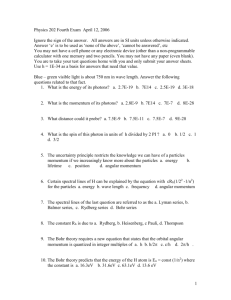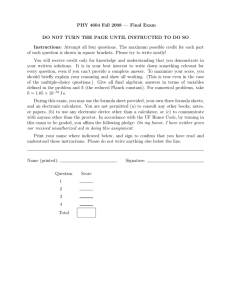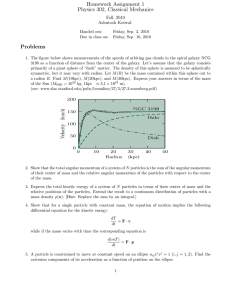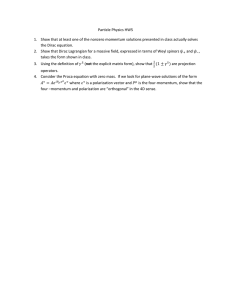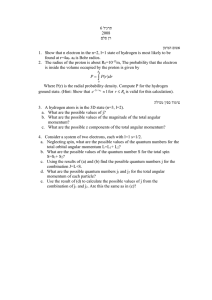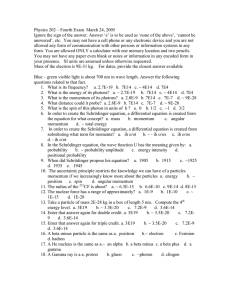Physics 202 Fourth Exam April 19, 2007
advertisement
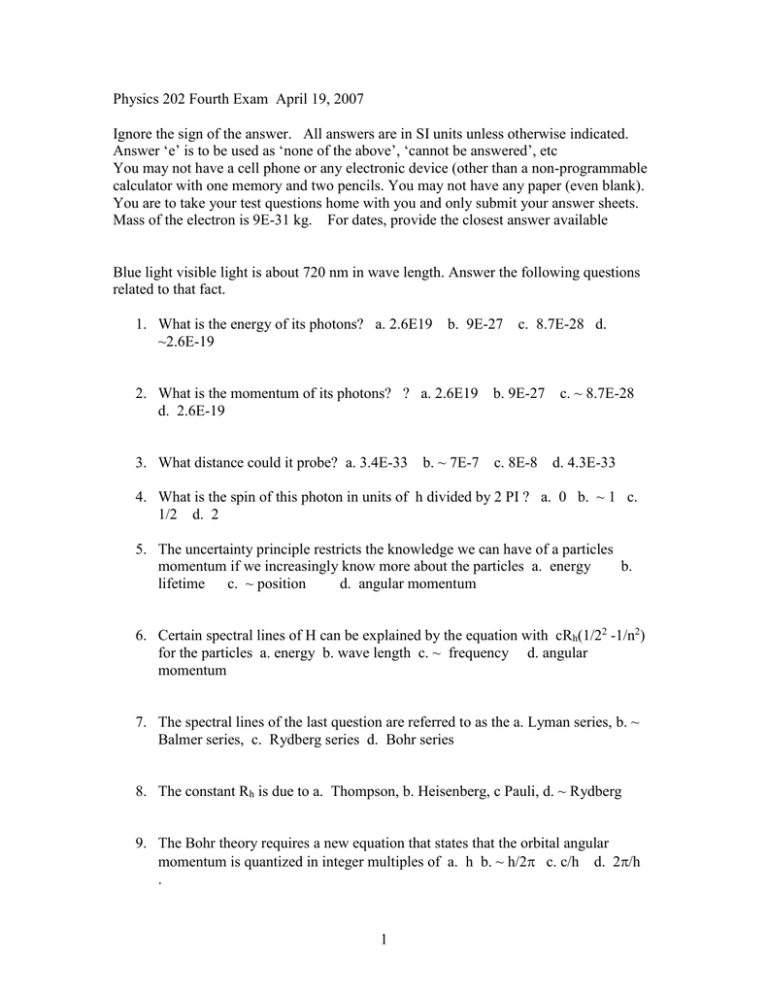
Physics 202 Fourth Exam April 19, 2007 Ignore the sign of the answer. All answers are in SI units unless otherwise indicated. Answer ‘e’ is to be used as ‘none of the above’, ‘cannot be answered’, etc You may not have a cell phone or any electronic device (other than a non-programmable calculator with one memory and two pencils. You may not have any paper (even blank). You are to take your test questions home with you and only submit your answer sheets. Mass of the electron is 9E-31 kg. For dates, provide the closest answer available Blue light visible light is about 720 nm in wave length. Answer the following questions related to that fact. 1. What is the energy of its photons? a. 2.6E19 ~2.6E-19 b. 9E-27 c. 8.7E-28 d. 2. What is the momentum of its photons? ? a. 2.6E19 d. 2.6E-19 b. 9E-27 3. What distance could it probe? a. 3.4E-33 c. 8E-8 b. ~ 7E-7 c. ~ 8.7E-28 d. 4.3E-33 4. What is the spin of this photon in units of h divided by 2 PI ? a. 0 b. ~ 1 c. 1/2 d. 2 5. The uncertainty principle restricts the knowledge we can have of a particles momentum if we increasingly know more about the particles a. energy b. lifetime c. ~ position d. angular momentum 6. Certain spectral lines of H can be explained by the equation with cRh(1/22 -1/n2) for the particles a. energy b. wave length c. ~ frequency d. angular momentum 7. The spectral lines of the last question are referred to as the a. Lyman series, b. ~ Balmer series, c. Rydberg series d. Bohr series 8. The constant Rh is due to a. Thompson, b. Heisenberg, c Pauli, d. ~ Rydberg 9. The Bohr theory requires a new equation that states that the orbital angular momentum is quantized in integer multiples of a. h b. ~ h/2 c. c/h d. 2/h . 1 10. The Bohr theory predicts that the energy of the H atom is En = const (1/n2) where the constant is a. 16.3eV b. 31.6eV c. 63.1eV d. ~13.6 eV 11. The second orbit of the H atom will have a diameter in Angstroms of about a. 7 b. ~ 9 c. 3 d. 1 12. The energy of the 3rd level of hydrogen is approximately (in eV)? a. 1.5 b. 3 c. 4.5 d. 1.1 13. The quantization of angular momentum comes from requiring that the electron wave must meet itself in constructive interference and thus an integral number of waves must exactly equal the a. radius b. ~ circumference c. energy d. angular momentum 14. How many angular momentum values are there in the L shell a. 1 b. ~ 2 c. 3 d. 4 15. How many electrons are allowed in the L shell a.~ 8 b. 18 c. 4 d. 9 16. The ratio of the width of the atom to the nucleus is about 10 to what power ? a. 2, b. 3, c. 4 d. ~ 5 17. Compute the half life of a radioactive substance with a = 11 a. 6.3 c. 0.063 d. 15.87 b. 0.63 18. The SI unit of activity is the a. Currie b. ~ Becquerel c. REM d. rad 19. If a 9 kg of a substance has a half life of 50 years then how much is left after 500 years. a.~ 8.79E-3 b. .0176 c. .035 d. 4.5 20. If the RBE factor for alpha particles is 15, and the dose in rem is 60, then what is the dose in rads? a. ¼ b. ½ c. 1 d. 2 e. 4 21. The radius of the 238U is about? 0.526E-10 a. 4.7E-15 2 b. 7.4E-15 c. 1.2E-15 d. 22. A beta minus particle is the same as a. positron d. hadron b. ~electron c. Fermion 23. An He nucleus is the same as a. ~ an alpha b. a beta minus c. a beta plus gamma d. a 24. A neutron that is free will decay into a proton, beta minus, and a. an electron neutrino b. ~ an electron antineutrino c. a muon neutrino d. photon 25. When a nucleus has too many neutrons, what reaction is likely to occur if it is not alpha decay? a. beta plus b. ~ beta minus c. gamma d. neutron emission 26. What element (actually nucleus) has the largest binding energy per nucleon? a. Ne b. H c. U d. ~ Fe 27. Particles that have a half integer spins (1/2, 3/2, ….) times h/2pi are called? a. Gluons b. ~ Fermions c. Hadrons d. Bosons 28. Particles that have integer spins (0, 1, 2, …) times h/2pi are called a. Gluons b. Fermions c. Hadrons d. ~ Bosons 29. In a beta plus decay, what particle would be ejected from the nucleus that has no charge? a. neutron b. pion c. ~ electron neutrino d. electron antineutrino 30. The number of elements that are in the periodic table can be approximately understood in terms of the ratio of the strong force to which force? a. weak gravitational c. ~ electromagnetic d. elastic b. 31. Nuclear structure and atomic structure are both totally dependent for their very existence upon a. Boson statistics b. quantized energy levels c. Heisenberg uncertainty principle d. exclusion principle (choose best answer from these not e) 3 32. Assume alpha decay of 238U -> AX + then what is the value of A: a. 238 b. 242 c. ~ 234 d. 235 33. Assume alpha decay of 238U -> AX + then what is the value of X: a. ~ Th b. U c. Pu d. Pa 34. How dangerous would this radioactivity be while outside your body such as one gram of this material in your hand: a. extremely dangerous b. dangerous c. ~ not dangerous 35. When did Heisenberg propose his equation? d. 1935 e. 1945 a. 1905 b. 1915 c. ~1925 36. When did Dirac show that the Schroedinger and Heisenberg equations were equivalent? a. he did not show that result, b. 1916, c ~1926 d. 1936 e. 1946 37. The nuclear force has a range of approximately? a. 1E-9 1E-15 d. 1E-28 b. 1E-10 c. ~ 38. Take a particle of mass 2E-28 kg in a box of length 9 nm. Compute the wave length of the lowest level. a.~ 1.8E-8 b. 1.8E-9 c. 9E-9 d. 9E-8 39. Enter that answer again for double credit. a.~ 1.8E-8 9E-8 b. 1.8E-9 c. 9E-9 40. When an electron and a positron collide, one produces a. ~ photons c. an alpha particle d. hadrons 41. The proton is actually a compose of a. ~ quarks d. hadrons b. leptons b. pions c. mesons 42. Particles that are engage in the strong interactions are are called a. Gluons Fermions c. ~ hadrons d. Bosons 4 d. b. 43. Ferimions do not engage in strong interactions are called? a. bosons hadrons c. ~ leptons d. mesons b. 44. Which particles are conserved (like charge is conserved) a. leptons, b. ~ both leptons and baryons, c. baryons, d. hadrons, e. quarks 45. Quarks are held together by the exchange of a. leptons photons d. gravitons b. ~ gluons 46. The electromagnetic force is due to an exchange of a. leptons c. ~ photons d. gravitons c. b. gluons 47. Most of the energy and matter in the universe are of a totally unknown form described at present with the adjective a. grey b. ~ dark c. black d. white 48. The prediction of antimatter was due to a. ~ Dirac d. Fermi b. Pauli 49. The first sustained nuclear reaction was created by a. Dirac Einstein d. ~ Fermi 50. The explanation of the photoelectric effect was due to a. Dirac ~ Einstein d. Fermi c. Einstein b. Pauli c. b. Pauli c. 51. Compelling evidence (in addition to the expansion of the universe) for the original big bang comes from? a. ~ cosmic background radiation b. the ratio of H to He c. the number of elements in the periodic table d. the existence of antimatter 52. Planks discovery occurred about a. 1905 b. 1915 c. 1865 d. 1925 e. ~1900 53. Fermi’s creation of the sustained nuclear fission occurred about a. 1935 b. 1925 c. 1950 d. 1955 e. ~1945 54. Recently using high energy accelerators physicists have been able to extract an individual quark from the a. neutron b. proton c. W particle d.~ has not occurred 5 6
